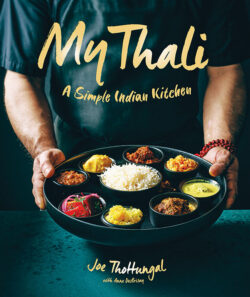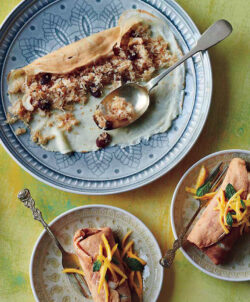Canadians have developed a global palate as a nation with vast multicultural communities and adventurous travellers. Indian food has become mainstream, and with it, a wider variety of desserts to discover.
Coconut Lagoon and Thali
Joe Thottungal owns two restaurants in Ottawa, Coconut Lagoon and Thali. The much-lauded chef has also written two cookbooks, Coconut Lagoon: Recipes from a South Indian Kitchen and My Thali: A Simple Indian Kitchen, the latter of which recently won the 2023 Gourmand World Cookbook Award in the Indian category. Of course, he has included some of his best-loved Indian dessert recipes between the pages.
The chef explains that while Indian desserts are part of celebrations and festivities, sweets are part of everyday life. “There is no doubt we like our sweets in India. At almost every meal, there is a fruit pudding or a scented custard and a myriad of little pick-me-up treats that can be enjoyed at a market stall, a street vendor or at home with an afternoon chai.”
Growing up in India, Thottungal’s favourite childhood dessert was rice phirni. He still craves it today, not only for its delicious taste but for nostalgic memories. “It’s so comforting, and I loved eating it every day. There was always a bowl for me and my siblings after school.”

Joe Thottungal’s book, My Thali, won the 2023 Gourmand World Cookbook Award in the Indian category.
PHOTO: CHRISTIAN LALONDE
Of course, the dessert is on his restaurant menus today. Rice and sugar are slow-cooked in saffron and rose water-infused milk. Afterwards, it’s refrigerated until set, then topped with coarsely chopped almonds, pistachios and a sprinkle of rose petals for garnish.
Fruit desserts in My Thali: A Simple Indian Kitchen include pineapple kesari, a flavourful pudding made with semolina. The word kesari means yellow, and the colour comes from saffron. Pineapple kesari also contains raisins and cashews. Jackfruit payasam is another popular fruit pudding. The fruit is combined with cashews, raisins, sugar and fragrant spices like cardamom, ginger, and cumin.
You’ll also find a recipe for cashew balls in honour of the chef’s Aunt Mary. “These nutty confections are also known as unda. The crunchiness comes from roasted rice, the flavour from cashews, and the sweetness from jaggery,” Thottungal says. If you are unfamiliar with it, jaggery is a hardened block of sugar obtained from palm sap. He says an alternative is muscovado sugar or dark brown sugar.
In Coconut Lagoon: Recipes from a South Indian Kitchen the coconut and jaggery crepes recipe is shared. These sweet crepes are filled with grated fresh coconut and jaggery syrup. If desired, they can also contain raisins and cashews.
Thali restaurant’s top-selling desserts are gulab juman and coconut ice cream. Gulab jamun is one of the most famous Indian desserts. The small dough balls are fried and steeped in syrup. Gulab means rose in Hindu, while the word jamun is the java plum fruit, which is small like a berry.
Thottungal says, “The key to success is kneading the dough until soft. The dough balls should not have any cracks in them. The syrup contains rose water, so it must be the best quality to enhance the flavour.”
At Coconut Lagoon, patrons craved the mango mousse, jackfruit ice cream, and vattalappam. “ It’s like a crème caramel but made with coconut milk and palm sugar,” Thottungal explains.
Misra Sweet Finales
Noorayn Meraj attended the Culinary Academy in India, later moving to and working in London, England. Lockdown in Toronto inspired her to set up an online Indian sweet catering company called Misra Sweet Finales. Although the business specializes in Indian desserts, it also offers some classics and fusion creations.

Joe Thottungal’s sweet coconut and jaggery crepes are filled with grated fresh coconut and jaggery syrup. If desired, they can also contain raisins and cashews.
PHOTO: CHRISTIAN LALONDE
One sweet on the menu customers love is jalebi. It’s a dough poured into hot oil by hand in swirling circular motions. “The key to making a good jalebi is a nicely fermented dough that gives a tinge of sourness. That is what we strive for.”
Once cooked, the dough is dipped in syrup. Meraj shares her tips and preferences. “The syrup has to have the right sweetness; a hint of cardamom and saffron elevates this to the next level. The thickness of the jalebi is crucial, too. Every millimetre increase affects the overall taste and sweetness quotient. My favourites are thin, slightly caramelized, and served hot. A great accompaniment for jalebi is rabri, a mildly flavoured milk reduction cooked on a slow flame for a few hours.”
Kaju katli is a dessert made entirely from cashew nuts and sugar. “It’s a cousin to almond-based marzipan,” Meraj explains. “I use the best quality cashew nuts I can find. I grind them into a fine powder and cook them in sugar syrup. It requires constant stirring and a thermometer to check the temperature. It’s set into sheet pans and cut into diamonds.”
Double ka meetha is an Indian bread pudding made from double roti. Meraj says, “Double roti is a colloquial name for bread in India and refers to bread that doubles in size owing to fermentation. This dessert is native to the city of Hyderabad, where I come from. The key to a good double ka meetha is using stale bread, which lets it absorb all the liquid and yet gives you a firm bite around the corners.”
Meraj explains how this traditional dessert is made. “The bread is cut into cubes, deep fried to a golden brown and stewed in a milk and sugar syrup concoction with cardamom and saffron. Topped with reduced milk solids and dry fruits, it’s a delicacy you find at almost all Hyderabadi weddings. When traditionally cooked on a wood fire, the smoke renders this wedding favourite dessert an unmatchable flavour.”
Then she points to another dessert, “Firni is a pudding made from milk and finely ground rice. At its most authentic, it is set and served in clay pots. The starch in the rice causes it to set and gives it a firm yet creamy texture. The trick to getting it perfect is to have a high ratio of milk to rice. A gentle essence such as rosewater can elevate it more. A good sprinkle of slivered almonds and pistachio finishes it beautifully.”
As for fusion desserts, Misra Sweet Finales bakes a marsala chai pannacotta. It’s inspired by the classic Italian dessert but with the addition of marsala chai spice and the flavours of Orange Pekoe tea leaves.
Are you looking for something different for your dessert menu? Indian sweets may offer a solution. Given the popularity of savoury Indian food in Canada, desserts may soon follow. / BJ
Karen Barr is an Ottawa-based writer and licensed chef who travels the world to explore topics about food and culture.
